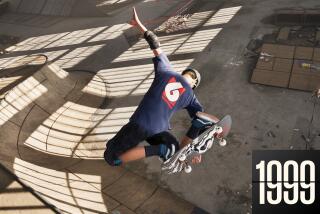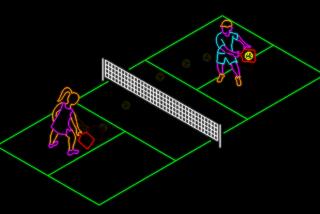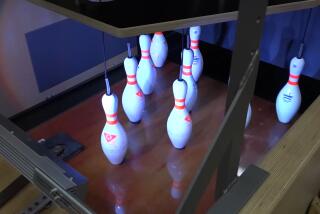Plastic: It’s a Whole New Game : For winter weary (or just weary) athletes, the game has been a back-yard national pastime for 40 years.
- Share via
This time of year, when the annual calendar is half-past baseball season, “Step up to the plate” is generally an invitation to finish off whatever rich foods are left over from the holidays.
And unfortunately, because daylight hours are now as short and chilly as ever, recreation for many of us is defined as anything that gets us up and off the couch.
But for winter-weary athletes who pine for the feel of bat and ball (and the sound of plastic against plastic), whiffle ball beckons like an old friend.
The game, celebrating its 40th anniversary, has become the back-yard national pastime because of its safety, low equipment price and adaptability. Whoever organizes the game can choose the playing field, the number of players and even the rules.
Whiffle ball is exceptionally kind to out-of-shape muscles, because batters do not run around bases. If a batter gets a base hit, an imaginary runner takes the base and advances to score only after other base hits or home runs. Base hits are determined by where the ball lands and whether it is caught on the fly.
Equipment is cheap: about $3 for a plastic bat and ball. Because the ball is difficult to hit more than 40 yards or so, the game can be played easily in a yard or in a driveway and street. Tennis courts make ideal whiffle fields, because they have lights for nighttime play and built-in demarcations for hits and outs.
Norm Samson, 37, of Orange has been organizing tennis court whiffle games sporadically since his high school days. In these easygoing, low-pressure contests, the batter stands on one side of the center net and the pitcher and fielders on the other side. A ball hit into the net is an out, as is any ball caught on the fly.
If the ball lands in the serving area of the court, the batter is awarded a single, Samson says. The area between the serving area and the fence is a double, and a ball hit off the fence is a triple. Over the fence is a home run, but a hit over either side fence is a foul--and the batter has to fetch the ball.
Beyond these basic rules, teams customize their own. “The rules change every time we play,” Samson admits. “You add new ones and delete old ones.”
For example, one rule now in vogue says that if a ball is hit off the back fence, the batter gets a triple, but an out is also recorded if a fielder catches the ball before it hits the ground. Likewise, Samson says, a fielding team can move a player outside the court, into home run territory, to catch the home run for an out.
The batting team also has some unusual options. To avoid a ground out, the batter can try to retrieve the ball before it bounces into the center net. Or, if a pitch is popped up on the batter’s side of the net, the batter can run over and take another swipe at the ball as it comes down.
The Wiffle Ball is a home-grown, American invention, born of an idea and ingenuity. David N. Mullany, a car polish salesman, produced the first Wiffle Ball in 1953 in Fairfield, Conn., after watching his son and friends play ball with a broomstick and plastic golf balls.
“He had played semipro baseball, and knew that it wasn’t good for young kids’ arms to try to throw a curve with those balls,” says David J. Mullany, vice president of Wiffle Ball Inc. of Shelton, Conn., and grandson of the inventor. “He thought if he cut holes in plastic balls in various configurations he’d find one that would curve on its own. So he sat down with my father and experimented.”
In the inventor’s back yard, his son and a friend tested the curving potential of various designs by pitching and batting (a swing and miss was called a “whiff”--hence the eventual name). The best-curving ball was the one with eight-inch long holes cut into one side, and that has remained the design.
The company also produced thin wooden bats until the early 1970s, when a formula for a solid-plastic bat was perfected.
As are the rules of the game, the yellow plastic bats are subject to customizing at the hands of whiffle enthusiasts who want better performance. Samson has made half a dozen models, using lengths of broom handles taped to the business end of the plastic bat.
“The problem is they don’t make an adult Wiffle bat--they’re all 28 inches and too short,” Samson says. “My best bats are the ones where the broom handle goes all the way through the plastic bat, to the end. I’ve got washers inserted into some of them to make them heavier.”
In all, the gear required for an afternoon on the whiffle court is lightweight and simple, Samson says--including the portable scoreboards, “pine tar” rags and coolers of beer that over the years have become standard equipment.
More to Read
Go beyond the scoreboard
Get the latest on L.A.'s teams in the daily Sports Report newsletter.
You may occasionally receive promotional content from the Los Angeles Times.










